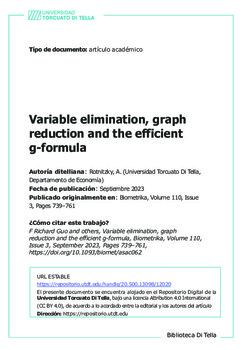Variable elimination, graph reduction and the efficient g-formula

View/
Metadata
Show full item recordAuthor/s:
F Richard Guo
Emilija Perković
Andrea Rotnitzky
Date:
2023Abstract
We study efficient estimation of an interventional mean associated with a point exposure treatment under a causal graphical model represented by a directed acyclic graph without hidden variables. Under such a model, a subset of the variables may be uninformative, in that failure to measure them neither precludes identification of the interventional mean nor changes the semiparametric variance bound for regular estimators of it. We develop a set of graphical criteria that are sound and complete for eliminating all the uninformative variables, so that the cost of measuring them can be saved without sacrificing estimation efficiency, which could be useful when designing a planned observational or randomized study. Further, we construct a reduced directed acyclic graph on the set of informative variables only. We show that the interventional mean is identified from the marginal law by the g-formula (Robins, 1986) associated with the reduced graph, and the semiparametric variance bounds for estimating the interventional mean under the original and the reduced graphical model agree. The g-formula is an irreducible, efficient identifying formula in the sense that the nonparametric estimator of the formula, under regularity conditions, is asymptotically efficient under the original causal graphical model, and no formula with this property exists that depends only on a strict subset of the variables.
Este artículo se encuentra publicado en Biometrika, Volume 110, Issue 3, September 2023, Pages 739–761,
